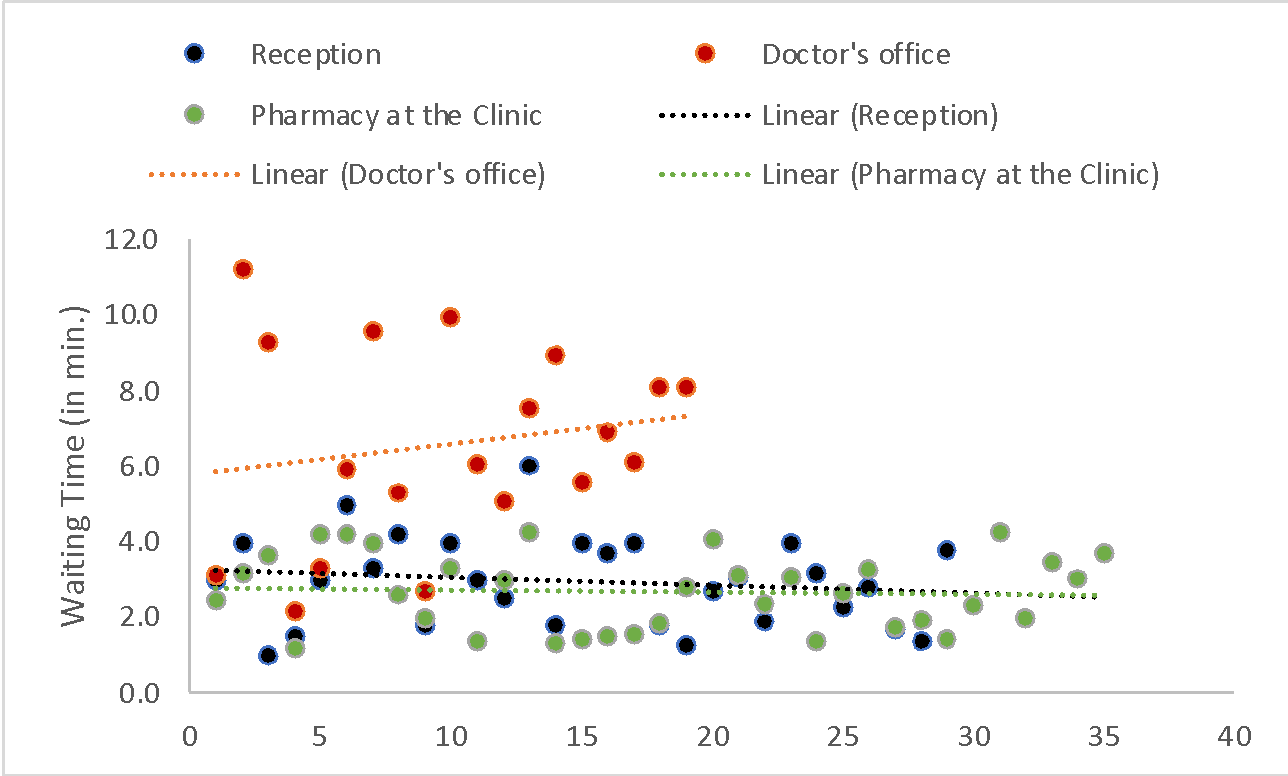Introduction
The clinical environment is fraught with many threats and challenges that can impede effective care and the overall quality of health care in the community. One such threat is long waiting times in the queue, which causes a drop in clinical productivity. The long waiting time for patients in an actual queue to see a doctor is also dangerous in terms of the spread of hospital-acquired infections because the queue is close contact between different people (Sikora & Zahra, 2021). This paper uses waiting time in the queue in terms of the variable under study; it is recognized that the threat of long waiting time is disruptive to clinical performance, so the work is aimed at improving the current agenda. The paper uses the LEAN SIX SIGMA model as a tool to explore and identify potential improvements.
DMAIC
Define
The current problem is an essential threat to clinical performance and public health in general, undermining trust in healthcare providers and inhibiting positive treatment outcomes. Fixing the current agenda involves improving the organizational well-being of clinical organizations and investing in a more comfortable and enjoyable patient-facility interaction experience. From the client’s perspective, the improvements presented are expected to help resolve dissatisfaction with waiting times and improve communication between the patient and providers; in the longer term, this means creating a more welcoming atmosphere within the clinic and the opportunity to focus on solving health-related problems. Thus, working to reduce waiting times at clinical site queues is the first priority addressed in this paper.
Measure
In terms of the measurement method, a stopwatch is used to examine the behavior of three different queues: the reception area where patients check in for their appointments, the doctor’s office, and the pharmacy branch of the clinic. The waiting time in each of the queues is carefully measured for each person, and the data are recorded in a pivot table (Appendix A). It is noteworthy that sample sizes were unequal, which is natural for different sites-the pharmacy branch was more popular with people than the therapist’s office. More specifically, the distribution of the number of participants in each sample was as shown in Table 1; the largest sample size — but not the maximum average waiting time — was specific to the pharmacy.
Table 1. Descriptive Statistics for the Three Samples

Analyse
Analyzing the results, it is well seen that the waiting time at the pharmacy is the shortest, while in contrast, the waiting time for patients near the therapist’s office was the longest. In terms of group behavior, Figure 1 shows that over time, the average waiting time for the receptionist and the pharmacy branch slowly fell (slope of the trend line), whereas, for the physician’s office, this value grew. The detected difference between the mean values should be evaluated with ANOVA because there is no guarantee that such differences are statistically significant for samples of varied sizes. The results of the one-way ANOVA test (Table 2) showed that the p-value was below the threshold value, which means that the statistical difference between the means is valid. To put it another way, the mean values between the three samples were indeed different. Based on these data, it can be concluded that the critical problem is centered around the therapist’s office – this clinical site took the longest wait time, so improvements should be targeted there.
Table 2. Results of the One-way ANOVA test
Improve
The fishbone model was used to analyze the current problem; since it was found that the queue near the doctor’s office was the longest, this was the sample used for analysis. Four key factors were identified, as shown in Figure 2. The main aspects of the problem were low client orientation, potential technical failures, lack of adequate shift scheduling, and ineffective patient appointment schedules. The aspects detected demonstrate opportunities for improvement; specifically, this refers to work to improve the technical equipment of the clinic, namely regular checks of equipment operability and prompt replacement possibilities. In addition, HR specialists are recommended to review shift schedules to ensure that at least two therapists are always active. From a client-centered perspective, re-training the therapists would be beneficial in order to perform their professional tasks competently. Finally, a revision of the patient appointment schedule with potentially shorter appointment times per client would be proper.

Control
Based on the proposed improvements, it can be assumed that wait times in line at the therapist’s office will be reduced if operational changes are implemented. It is recommended that an added round of observation of wait times with the control variables intact after the improvements are implemented — it is assumed that the results of such observation will show a reduction in average wait time in the queue. However, additional research is required to test this assumption. Improvement control can also be carried out with SOP, in which routine processes are critically examined. SOP implies the introduction of practices that allow standardization of quality and smooth operation. Strictly speaking, the use of SOP in a clinic should help set new standards of performance, modify the management of resources in the clinic, and avoid any interruptions. To introduce SOP, it is recommended that the clinic use known practice models of operational change, including problem analysis, finding proper resources, and planning for change.
Conclusion
It must be recognized that waiting time in the queue is a severe problem for the operations of a clinical organization. The current study observed three different sites within the same clinic and found that the average wait time to the therapist’s office was the highest. In other words, the critical problem of long wait times is centered on this particular site, so improvements and changes should focus on this aspect of the overall problem. Among the critical improvements suggested were revisions to current regulations and physician training, as well as changes in shift schedules and improvements in the technical equipment of the clinics.
Reference
Sikora, A., & Zahra, F. (2021). Nosocomial infections. NCBI. Web.